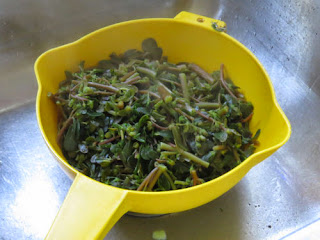 gallon of autumn olive juice (photo by jhy) gallon of autumn olive juice (photo by jhy) |
You will need:
- Autumn Olive berries- any amount, probably at least a quart to make the work worthwhile
- sugar or sugar substitute to taste
 gallon of autumn olive berries (photo by jhy) gallon of autumn olive berries (photo by jhy) |
Place your berries in a large kettle with about an equal amount of water. This doesn't have to be measured very accurately, but you want to leave plenty of space above the level of water in your kettle. Bring the berries to a boil.
 boiling autumn olive berries (photo by jhy) boiling autumn olive berries (photo by jhy) |
Simmer for about 30 minutes. Skim off any foam with a metal spoon. Let this cool until it's a temperature you can handle, but the warmer the better.
 autumn olive pulp in a jelly bag (photo by jhy) autumn olive pulp in a jelly bag (photo by jhy) |
As you can see, the resulting juice is a milky pink. This looks funny, but doesn't taste bad. I added a little bit of sugar, but it didn't need much. This can be added strictly to your own taste. If you really want a red color, you'll need to add food coloring.
I tried this method instead of the Cold Pack Autumn Olive Juice method because I was hopeful of getting a more tart flavor. The berries are pleasantly tart, but the cold pack juice method yields a juice that is very much like fruit punch. I was disappointed that this method does the same thing. The tartness must be all in the skins, and is not released even with the cooking the way it is with grapes.
Store in the refrigerator for quick use, or process in a boiling water bath for 10 minutes, for longer storage. See



